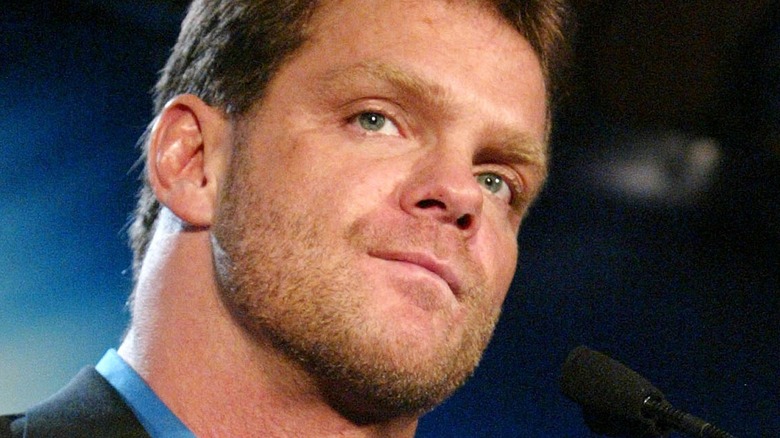In the annals of professional wrestling, few names elicit as much curiosity—and horror—as Chris Benoit. A man whose life and career spiraled into a tragic abyss, Benoit became the subject of intense debate and analysis, particularly concerning his mental health. What truly lay beneath the surface of this enigmatic athlete? At what point do we examine the correlation between the brutal sport of wrestling and the catastrophic brain damage that Benoit endured? These are not merely rhetorical questions; they represent a profound challenge to our understanding of athlete welfare and the responsibilities of organizations like WWE.
To unpack this issue, one must first consider the physicality inherent in professional wrestling. While many dismiss it as mere entertainment, the injuries and strains wrestlers endure are anything but superficial. Wrestlers like Benoit are subjected to a relentless barrage of concussions, forced to perform ad infinitum despite their ravaged bodies and minds. It is essential to highlight the fact that Benoit’s brain showed signs of chronic traumatic encephalopathy (CTE), a condition typically associated with severe head trauma. This brain disease doesn’t just cause memory loss and mood swings—it fundamentally alters personality and cognitive function, challenging the boundaries of who that individual was before damage set in.
But let us pause here and ask a provocative question: How culpable is the WWE in fostering an environment where such devastating brain injuries can flourish? Many might argue that wrestling is a voluntary profession—athletes willingly choose to step into the ring. Yet, this argument grossly oversimplifies the complexity of the situation. These men and women are conditioned from a young age to prioritize performance over health, often internalizing a culture of stoicism that discourages them from speaking out about their injuries. Add to this the pressure to maintain an image of toughness and resilience, and you have a recipe for disaster whose consequences extend far beyond the ring.
This leads to a crucial challenge: should we condemn Benoit solely for his infamous actions, or should we hold a mirror up to the institution that enabled his descent into madness? While his tragic end cannot be excused, it is vital to scrutinize the broader implications of his tale. Benoit’s life reflects an obligation on the part of wrestling organizations to invest in comprehensive brain health programs, ensuring that athletes receive the medical attention they require both during and after their careers. Merely offering cursory help or momentary therapies is not enough; it must be a full-scale initiative aimed at preventing, identifying, and treating brain injuries.
When examining Benoit’s legacy, one cannot ignore the emotional toll his actions took on his family and the wrestling community. For many, the horror of his double-murder-suicide overshadowed a career filled with remarkable accomplishments. Shouldn’t the ultimate tragedy be the loss of a talented performer whose potential was irrevocably stifled by a rotten system? This raises yet another challenging question: How do we reconcile our love for a sport that can be so damaging with the need to protect those who continually sacrifice their bodies for our entertainment?
The wrestling world has made incremental strides in addressing the urgent need for reform, but is it enough? Needle exchanges, while crucial, cannot substitute for meaningful systemic change. The WWE has faced litigation over its handling of brain injuries, yet the public relations strategy often feels disingenuous. They must be held accountable for promoting a culture that places the spectacle above the safety of its performers. One cannot shake the unsettling sensation that these athletes are not merely resources but pawns in a capitalist game that prioritizes profit over humanity.
Concussions are called the “silent epidemic” within sports. When we look at Chris Benoit’s situation through this lens, it becomes evident that wrestling and other contact sports cannot ignore the potential perils. As the science linking CTE and recklessness becomes increasingly irrefutable, fans, commentators, and organizations must rally to demand changes. Are we really willing to sacrifice more lives for the sake of entertainment? Will we continue to turn a blind eye to the truth until we are confronted with the aftermath of yet another tragic incident?
Perhaps the most troubling aspect of this narrative is how society encapsulates athletes. They are revered as modern warriors, yet this comes at a nearly crippling cost. The duality of celebration and condemnation remains at the forefront of Benoit’s legacy. He embodies the notion of an athlete caught within a vortex of expectations: to perform beyond human limits while silencing the cries of a battered mind. Do we fawn over gladiatorial prowess while ignoring the collateral damage left in its wake?
As wrestling enthusiasts, advocates for mental health, and responsible citizens, we are faced with a formidable crossroads. The imperative is clear: we must push for policies ensuring that the wellness of our athletes is prioritized above all else. For every breath taken within the ring, let us remember there’s a life attached to it—a life that deserves to be safeguarded from the lasting repercussions of a violent sport. Chris Benoit’s haunting legacy should not just serve as a cautionary tale; it should embolden reform that protects the very souls who entertain us.
